Region-Selective Corrosion for the Fabrication of Tilted Microfiber Bragg Gratings: A Candidate for the Monitoring of Buildings’ Health
Abstract
:1. Introduction
2. Materials and Methods
2.1. Simulation Model and TMFBG Structures
2.2. Sensing Theory
3. Results and Discussion
3.1. Structural Parameters and Transmission Spectrum
3.2. Sensing Performance Simulation
3.3. Fabrication and Sensing Experiment of Uniformly Etched TMFBG
3.3.1. Uniformly Etched TMFBG
3.3.2. Refractive Index-Sensing Characteristics
4. Conclusions
Author Contributions
Funding
Institutional Review Board Statement
Data Availability Statement
Acknowledgments
Conflicts of Interest
References
- Lou, J.Y.; Wang, Y.P.; Tong, L.M. Microfiber Optical Sensors: A Review. Sensors 2014, 14, 5823–5844. [Google Scholar] [CrossRef] [PubMed]
- Hwang, I.K.; Kim, S.K.; Yang, J.K.; Kim, S.H.; Lee, S.H.; Lee, Y.H. Curved-microfiber photon coupling for photonic crystal light emitter. Appl. Phys. Lett. 2005, 87, 131107. [Google Scholar] [CrossRef]
- Sulaiman, A.; Harun, S.W.; Ahmad, H. Ring microfiber coupler erbium-doped fiber laser analysis. Chin. Opt. Lett. 2014, 12, 021403. [Google Scholar] [CrossRef]
- Vienne, G.; Li, Y.H.; Tong, L.M. Microfiber resonator in polymer matrix. IEICE Trans. Electron. 2007, E90c, 415–421. [Google Scholar] [CrossRef]
- Zhang, Q.; Zhu, T.; Zhang, J.D.; Chiang, K.S. Micro-Fiber-Based FBG Sensor for Simultaneous Measurement of Vibration and Temperature. IEEE Photonics Technol. Lett. 2013, 25, 1751–1753. [Google Scholar] [CrossRef]
- Yue, X.; Lu, R.Y.; Yang, Q.C.; Song, E.L.; Jiang, H.C.; Ran, Y.; Guan, B.O. Flexible Wearable Optical Sensor Based on Optical Microfiber Bragg Grating. J. Light. Technol. 2023, 41, 1858–1864. [Google Scholar] [CrossRef]
- Kou, J.L.; Ding, M.; Feng, J.; Lu, Y.Q.; Xu, F.; Brambilla, G. Microfiber-Based Bragg Gratings for Sensing Applications: A Review. Sensors 2012, 12, 8861–8876. [Google Scholar] [CrossRef] [PubMed]
- Her, S.C.; Chung, S.C. Dynamic Responses Measured by Optical Fiber Sensor for Structural Health Monitoring. Appl. Sci. 2019, 9, 2956. [Google Scholar] [CrossRef]
- Cao, S.F.; Chen, R.P.; Yang, Q.C.; He, X.; Chiavaioli, F.; Ran, Y.; Guan, B.O. Point-of-care diagnosis of pre-eclampsia based on microfiber Bragg grating biosensor. Biosens. Bioelectron. 2024, 249, 116014. [Google Scholar] [CrossRef]
- Wang, G.G.; Shum, P.P.; Ho, H.P.; Yu, X.; Hu, D.J.J.; Cui, Y.; Tong, L.M.; Lin, C.L. Modeling and analysis of localized biosensing and index sensing by introducing effective phase shift in microfiber Bragg grating (μFBG). Opt. Express 2011, 19, 8930–8938. [Google Scholar] [CrossRef]
- Ismaeel, R.; Lee, T.; Ding, M.; Belal, M.; Brambilla, G. Optical microfiber passive components. Laser Photonics Rev. 2013, 7, 350–384. [Google Scholar] [CrossRef]
- Yan, Z.Y.; Wang, J.J.; Wang, C.Y.; Yu, R.W.; Shi, L.; Xiao, L.M. Optical microfibers integrated with evanescent field triggered self-growing polymer nanofilms. Opt. Express 2022, 30, 18044–18053. [Google Scholar] [CrossRef] [PubMed]
- Zhang, Y.X.; Pu, S.L.; Li, Y.X.; Hao, Z.J.; Li, D.H.; Yan, S.K.; Yuan, M.; Zhang, C.C. Magnetic Field and Temperature Dual-Parameter Sensor Based on Nonadiabatic Tapered Microfiber Cascaded With FBG. IEEE Access 2022, 10, 15478–15486. [Google Scholar] [CrossRef]
- Zhang, Y.; Lin, B.; Tjin, S.C.; Zhang, H.; Wang, G.H.; Shum, P.; Zhang, X.L. Refractive index sensing based on higher-order mode reflection of a microfiber Bragg grating. Opt. Express 2010, 18, 26345–26350. [Google Scholar] [CrossRef] [PubMed]
- Liao, C.R.; Yang, K.M.; Wang, J.; Bai, Z.Y.; Gan, Z.S.; Wang, Y.P. Helical Microfiber Bragg Grating Printed by Femtosecond Laser for Refractive Index Sensing. IEEE Photonics Technol. Lett. 2019, 31, 971–974. [Google Scholar] [CrossRef]
- Li, L.J.; Jia, C.Y.; Xu, T.Z.; Ma, Q.; Sun, J.H. High stability microfiber Sagnac loop liquid refractive index sensor with FBG mode selecting. J. Instrum. 2022, 17, P11029. [Google Scholar] [CrossRef]
- Zhi, Y.Y.; Li, X.; Li, Y.P.; Li, J.; Guan, B.O. Superstructure microfiber grating characterized by temperature, strain, and refractive index sensing. Opt. Express 2020, 28, 8853–8861. [Google Scholar] [CrossRef] [PubMed]
- Ahmed, F.; Jun, M.B.G. Microfiber Bragg Grating Sandwiched Between Standard Optical Fibers for Enhanced Temperature Sensing. IEEE Photonics Technol. Lett. 2016, 28, 685–688. [Google Scholar] [CrossRef]
- Ran, Y.; Jin, L.; Tan, Y.N.; Sun, L.P.; Li, J.; Guan, B.O. High-Efficiency Ultraviolet Inscription of Bragg Gratings in Microfibers. IEEE Photonics J. 2012, 4, 181–186. [Google Scholar] [CrossRef]
- Riza, M.A.; Go, Y.I.; Harun, S.W.; Maier, R.R.J. FBG Sensors for Environmental and Biochemical Applications-A Review. IEEE Sens. J. 2020, 20, 7614–7627. [Google Scholar] [CrossRef]
- Singh, Y.; Raghuwanshi, S.K.; Prakash, O.; Saini, P.K. Design and development of tilted fiber Bragg grating (TFBG) chemical sensor with regression analysis of grating parameters for sensitivity optimization. Opt. Quant. Electron. 2021, 53, 664. [Google Scholar] [CrossRef]
- Qi, J. A comparison study of the sensing characteristics of FBG and TFBG. Sensor Rev. 2013, 33, 68–79. [Google Scholar] [CrossRef]
- Kameyama, A.; Katto, M.; Yokotani, A. Influence of the cladding diameter of optical fiber on the simultaneous measurement of the refractive index and temperature of liquids using tilted fiber Bragg grating. Jpn. J. Appl. Phys. 2016, 55, 068003. [Google Scholar] [CrossRef]
- Tomyshev, K.; Dolzhenko, E.I.; Butov, O.V. Correlation between optical fibre diameter and characteristics of tilted fibre Bragg grating-assisted sensors. Quantum Electron. 2021, 51, 1113–1117. [Google Scholar] [CrossRef]
- Yang, H.; Li, X.W.; Lei, M.; Ouyang, H.; Li, Y.L. TFBG Side Modes and Fresnel Reflection-Based Sensing System for Solution Concentration Measurement. IEEE Sens. J. 2023, 23, 6901–6909. [Google Scholar] [CrossRef]
- Korganbayev, S.; Sypabekova, M.; Amantayeva, A.; González-Vila, A.; Caucheteur, C.; Saccomandi, P.; Tosi, D. Optimization of Cladding Diameter for Refractive Index Sensing in Tilted Fiber Bragg Gratings. Sensors 2022, 22, 2259. [Google Scholar] [CrossRef]
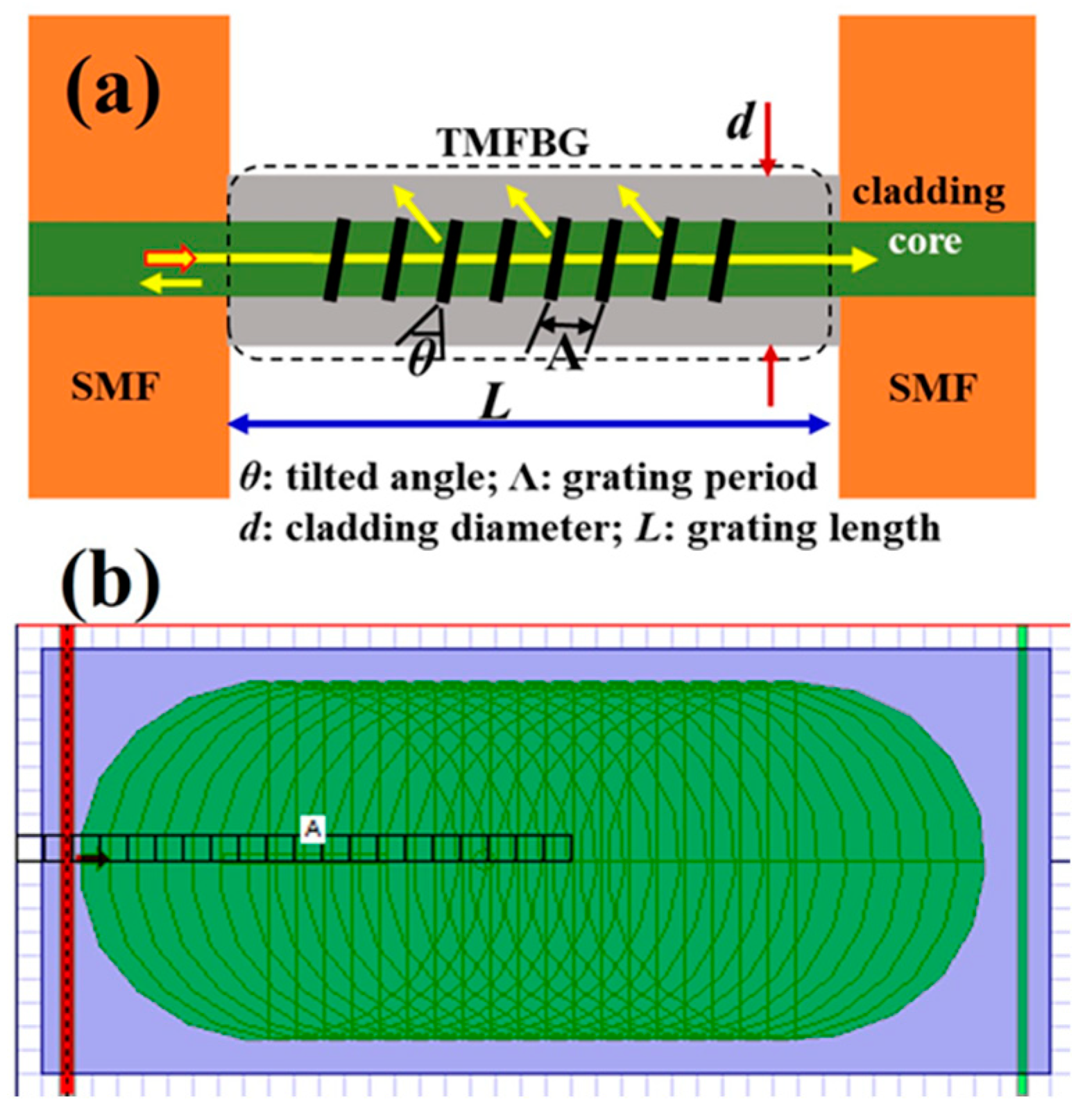
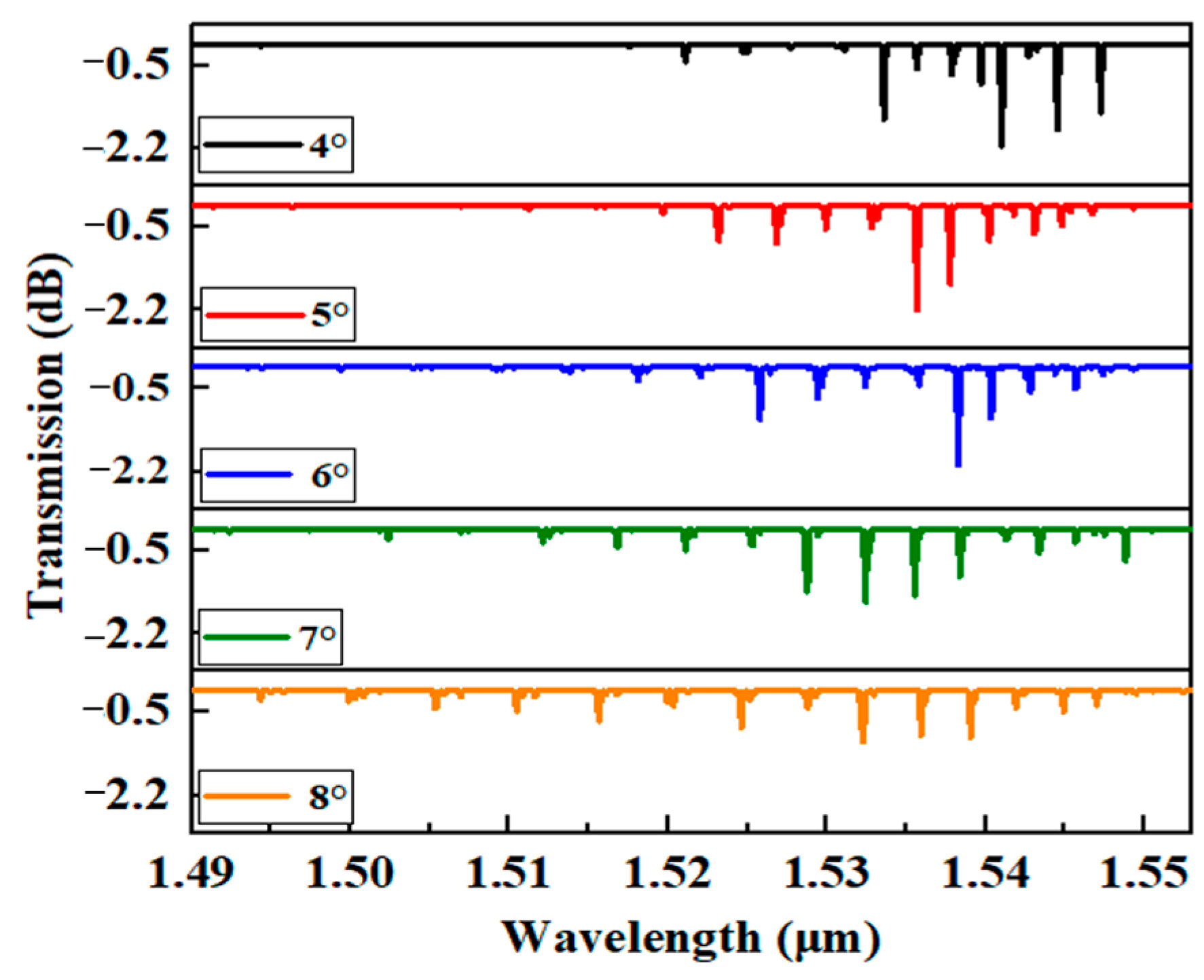




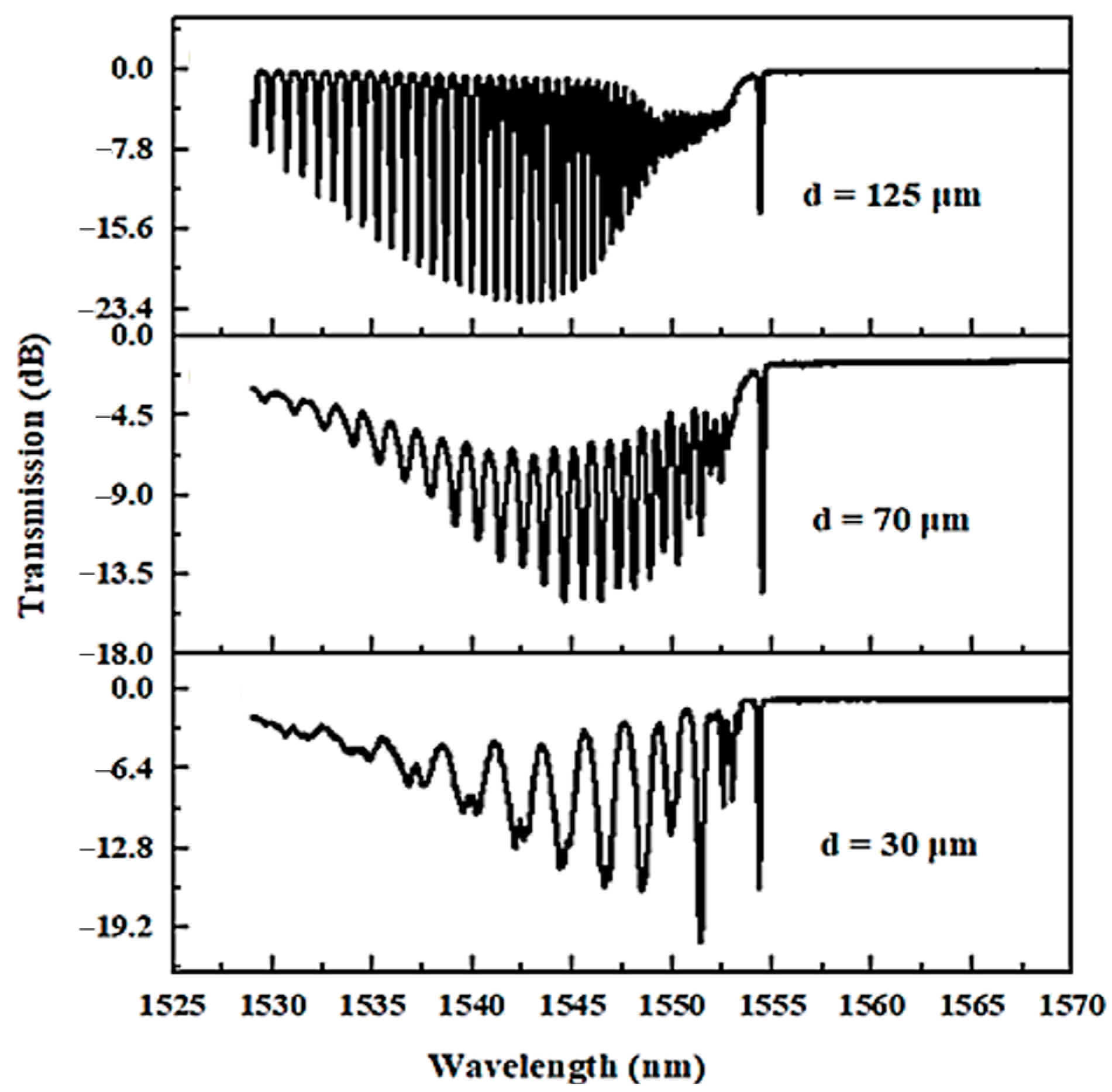
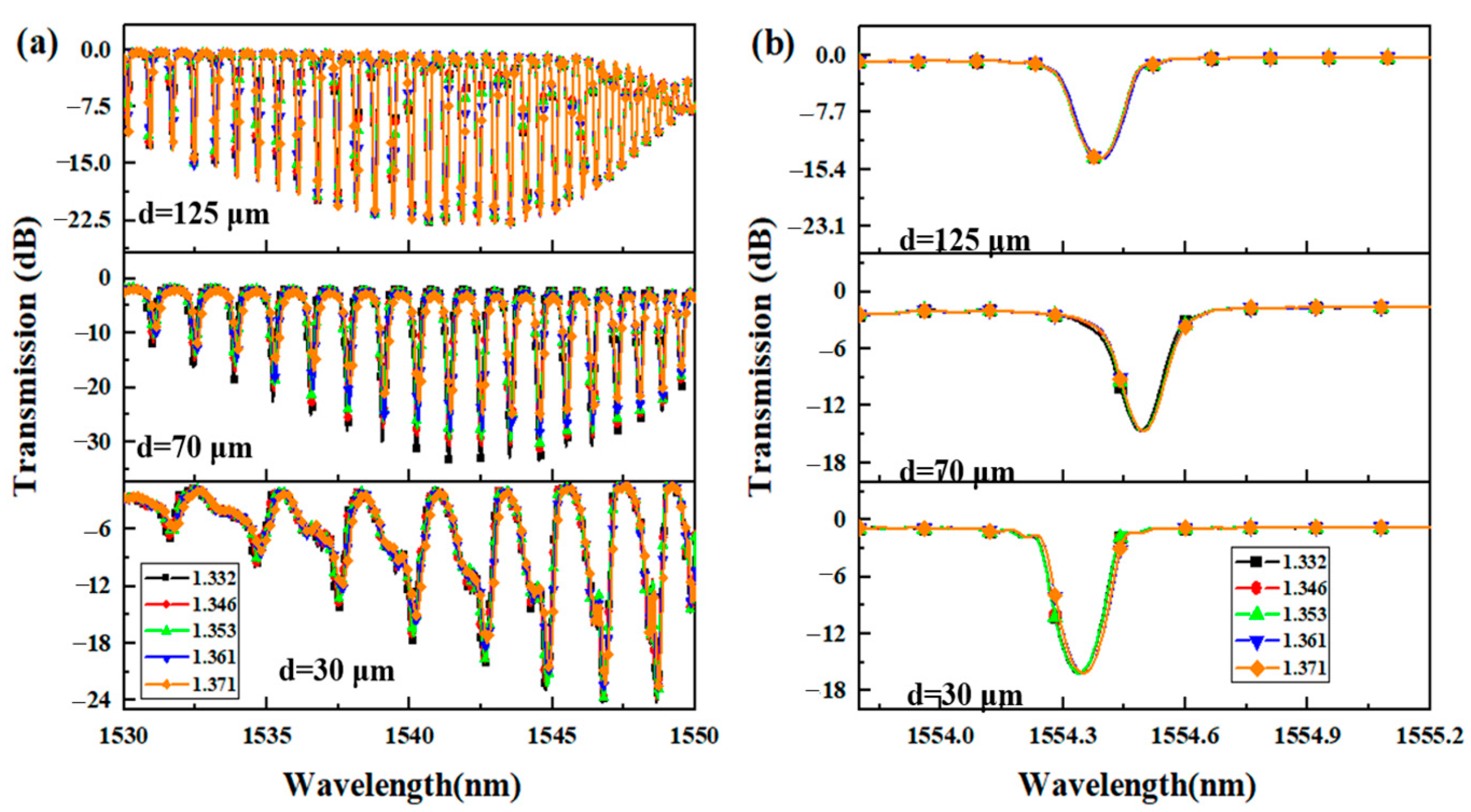
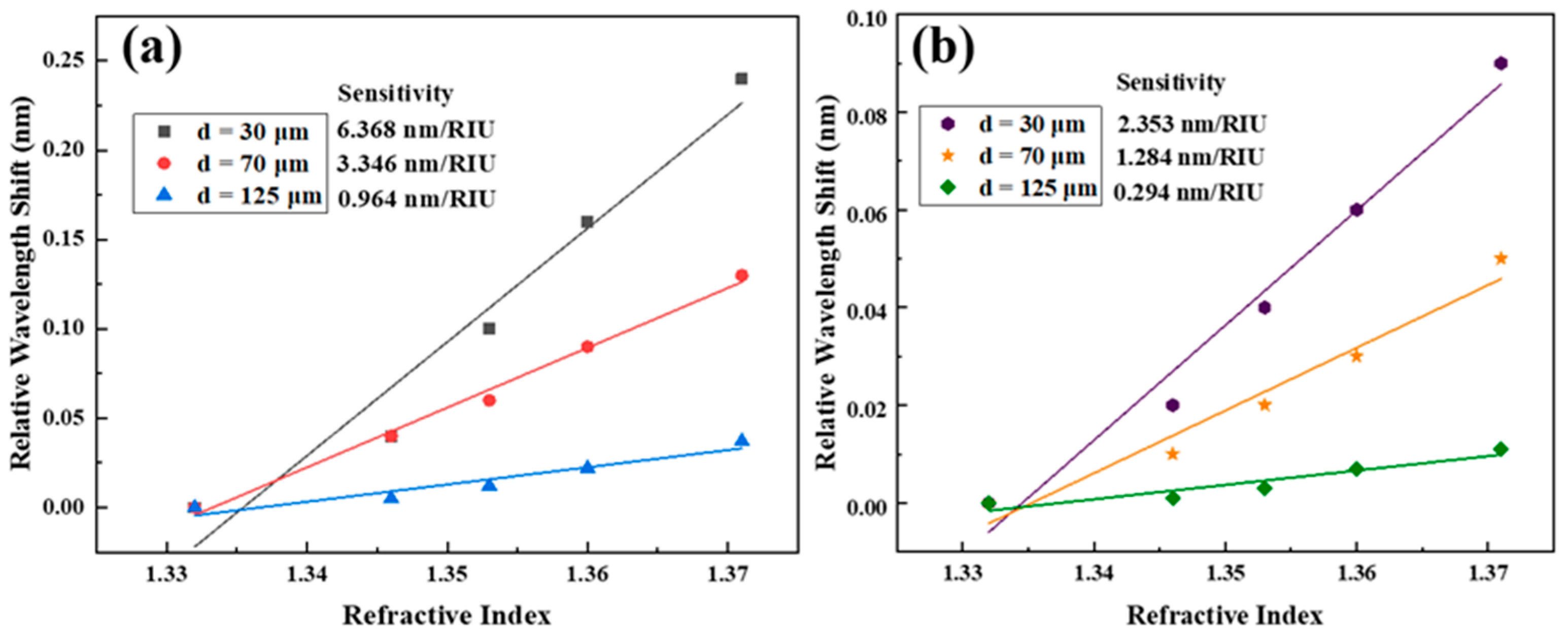
Disclaimer/Publisher’s Note: The statements, opinions and data contained in all publications are solely those of the individual author(s) and contributor(s) and not of MDPI and/or the editor(s). MDPI and/or the editor(s) disclaim responsibility for any injury to people or property resulting from any ideas, methods, instructions or products referred to in the content. |
© 2024 by the authors. Licensee MDPI, Basel, Switzerland. This article is an open access article distributed under the terms and conditions of the Creative Commons Attribution (CC BY) license (https://creativecommons.org/licenses/by/4.0/).
Share and Cite
Que, Y.; Li, J. Region-Selective Corrosion for the Fabrication of Tilted Microfiber Bragg Gratings: A Candidate for the Monitoring of Buildings’ Health. Appl. Sci. 2024, 14, 4707. https://doi.org/10.3390/app14114707
Que Y, Li J. Region-Selective Corrosion for the Fabrication of Tilted Microfiber Bragg Gratings: A Candidate for the Monitoring of Buildings’ Health. Applied Sciences. 2024; 14(11):4707. https://doi.org/10.3390/app14114707
Chicago/Turabian StyleQue, Yufei, and Jin Li. 2024. "Region-Selective Corrosion for the Fabrication of Tilted Microfiber Bragg Gratings: A Candidate for the Monitoring of Buildings’ Health" Applied Sciences 14, no. 11: 4707. https://doi.org/10.3390/app14114707






